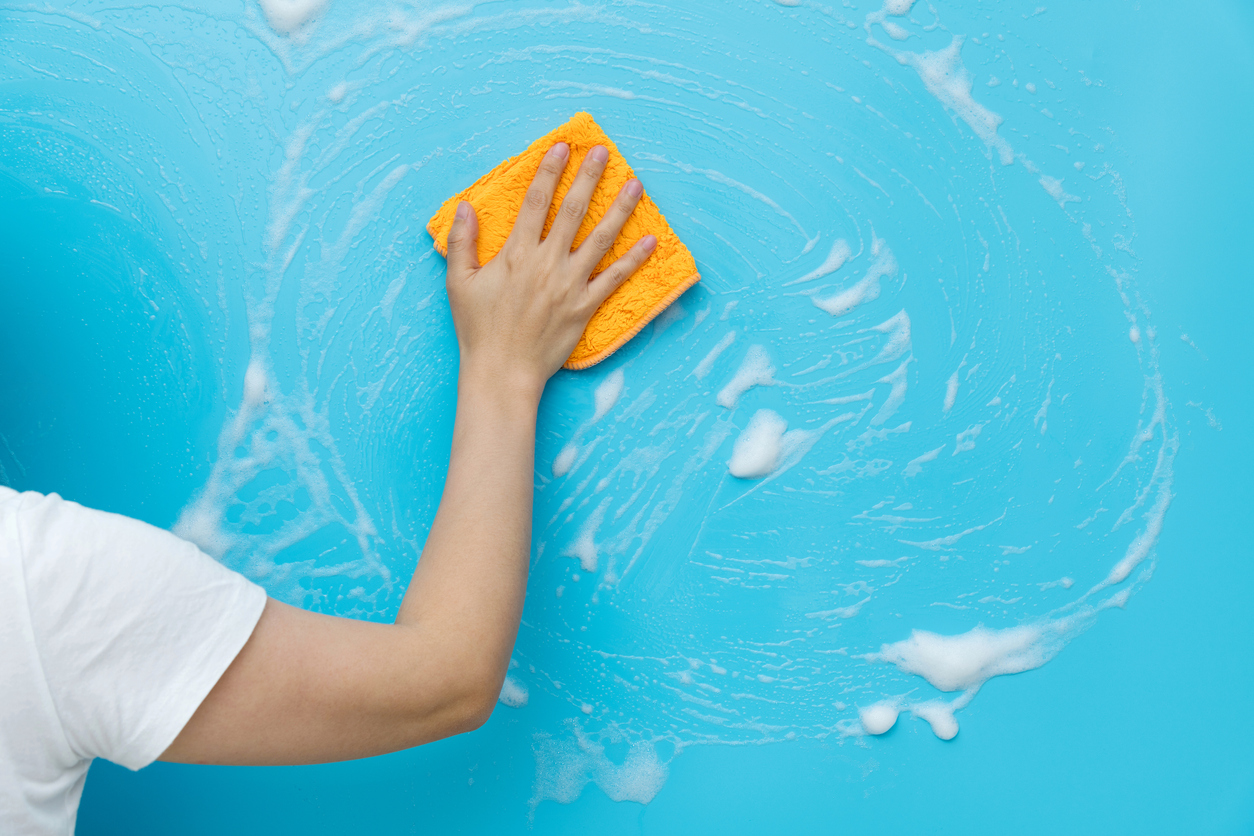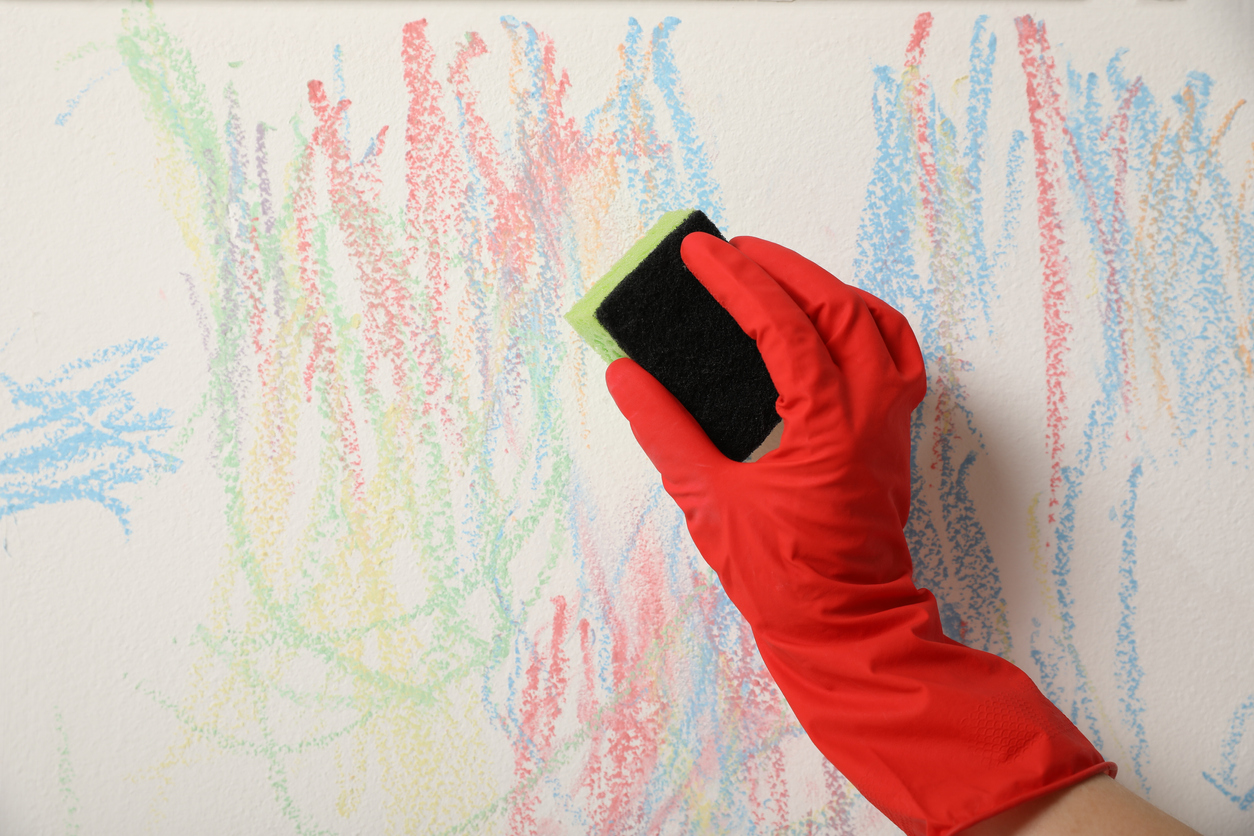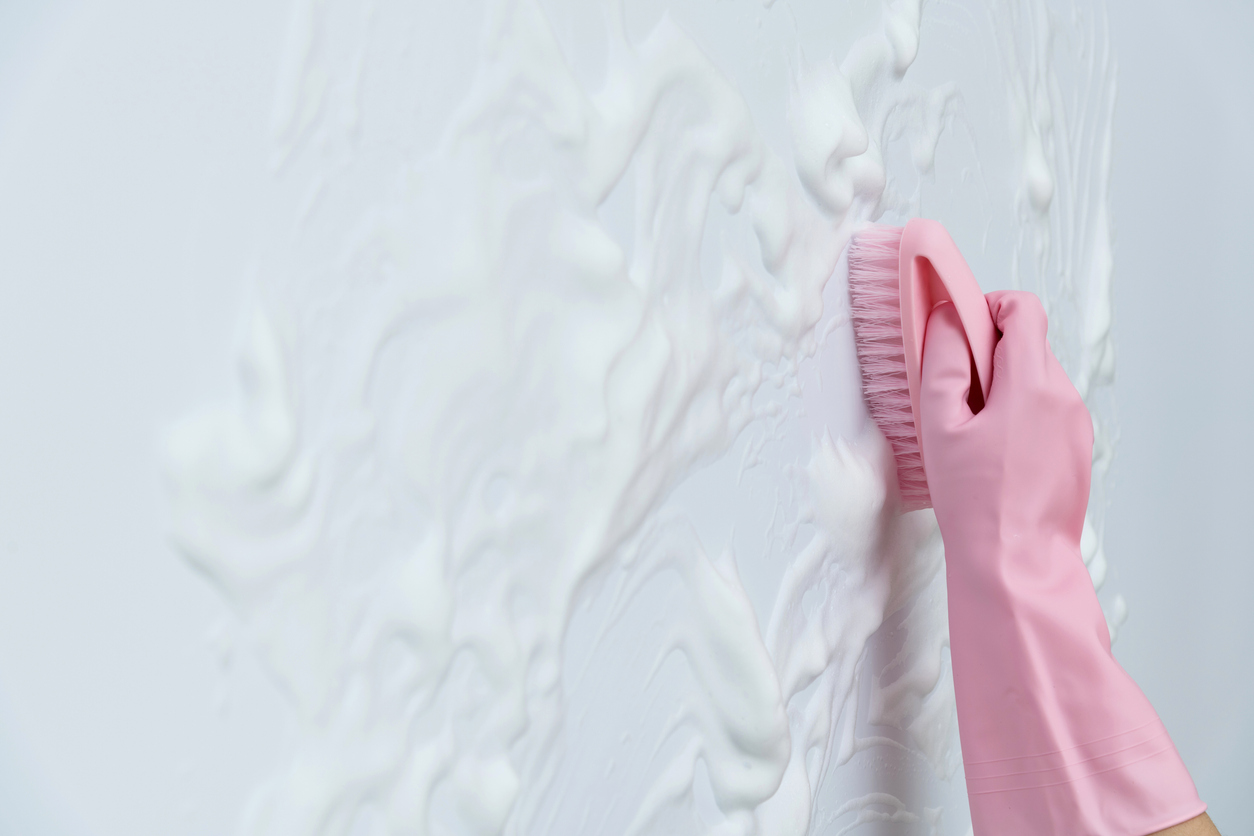

We may earn revenue from the products available on this page and participate in affiliate programs. Learn More ›
Life with toddlers can be…interesting. One minute they’re sitting calmly and playing with their toys on the floor, the next minute you turn around to find them drawing on the wall with a crayon. While finding crayon drawings on the wall is not a pleasant experience, it also isn’t a tragedy.
There are several methods for removing unwanted crayon marks—both from non-washable and washable crayons—from your painted walls. Many of these use cleaners or kitchen ingredients that you likely already have on hand, such as dish soap, baking soda, vinegar, and Magic erasers. The next few sections will explore a few of the most effective methods for how to get crayon off the wall.
RELATED: 15 Genius Coconut Oil Uses for Maintaining Your Home and Garden
How to Remove Crayon From Walls Using Dish Soap

A simple solution of dish soap and water can help you remove unwanted crayon markings from your painted wall. Just be careful to avoid getting too much water on the wall, as it could damage the paint or the drywall.
SUPPLIES
– Microfiber towels
– Gentle dish soap
– Water
– Small mixing bowl
STEP 1: Remove dust or loose debris from the wall.
Begin by using a dry microfiber cloth to wipe away any loose dust or debris. If loose particles are left on the walls, you’ll only end up spreading them around as you try to clean. Moreover, if there are any bits of crayon left, you’ll make new marks as you try to remove the old ones.
STEP 2: Mix soap and water to make a cleaning solution.
Add some warm water and a little dish soap—just a few drops will do—to a small mixing bowl or bucket. The water should have a few suds, but it shouldn’t be overly soapy.
STEP 3: Scrub the wall.
After combining the soap and water, Karina Toner, the operations manager of Spekless, a home cleaning company in the Washington, D.C., area, explains that you should “dampen a soft cloth or sponge in the soapy water solution.” Next, she says, “gently scrub the crayon marks on the wall with the damp cloth in circular motions.” But, she cautions to “avoid using excessive force to prevent damage to the paint.”
STEP 4: Rinse and dry the wall.
“Once the crayon marks are removed, rinse the area with a clean, damp cloth to remove any remaining soap residue,” explains Toner. She suggests finishing up by “[patting] the wall dry with a separate clean cloth.”
RELATED: 7 Reasons Why You Should Clean Your Walls More Often—and How to Do it Properly
How to Get Crayon Off Walls Using Baking Soda

Baking soda is an effective, natural cleaner. It is slightly abrasive, which is why it works so well at removing stains, such as those left behind by toddler crayons. Just be sure to test the cleaning solution in an inconspicuous spot before proceeding to make sure it doesn’t discolor the paint or otherwise damage the wall.
SUPPLIES
– Microfiber towels
– Baking soda
– Water
– Small bowl
STEP 1: Prepare the wall.
Remove loose dust and debris from the wall using a clean and dry microfiber towel.
STEP 2: Make a thick cleaning paste.
Make a cleaning paste using baking soda and water. Add 3 tablespoons of baking soda and 1 tablespoon of water to a small bowl. Mix the two ingredients together until they form a thick paste.
STEP 3: Scrub the crayon marks off of the wall.
Use the corner of a microfiber towel to pick up a small amount of the paste. Test the mixture in an inconspicuous area to confirm that it does not discolor the paint. Then, pick up more of the cleaning paste and use circular motions to rub it on the wall and remove any crayon marks.
STEP 4: Wipe down the wall.
Dampen a clean microfiber towel with plain water and use it to wipe the wall down and remove any baking soda residue. Rinse and repeat as necessary. Finally, use a clean and dry towel to remove any excess moisture.
RELATED: Dos and Don’ts of Repairing Drywall
How to Erase Crayon Marks On Walls With Vinegar

Vinegar is another kitchen ingredient that is good for so much more than just cooking. The versatile pantry staple can be used for a range of tasks including unclogging drains, controlling pests, sanitizing surfaces, and, yes, even removing crayon marks from walls. It works to break apart the wax substance crayons leave behind, making it possible to wipe the colors off of the wall with minimal scrubbing.
SUPPLIES
– Microfiber towels
– Distilled white vinegar
– Small bowl
– Soft-bristled brush or toothbrush
– Gentle dish soap and water (optional)
STEP 1: Clear loose debris or dust from the affected area.
Use a clean and dry microfiber cloth to wipe down the wall. Take care to remove any dust or debris to prepare the surface for cleaning and ensure you don’t end up spreading dirt around as you work.
STEP 2: Pour vinegar into a small container.
Distilled white vinegar works effectively to remove crayon from walls. Pour a few tablespoons into a bowl that you can carry with you to the area where you need to work.
STEP 3: Scrub the stain.
Use a soft-bristled brush to perform a spot test to confirm that the vinegar will not damage or discolor the paint finish. If all goes well, dip the brush into the vinegar again and gently scrub the affected areas using circular motions. If you don’t have a soft-bristled brush, an old toothbrush will work, too.
STEP 4: Rinse and dry the wall.
Dip a clean microfiber cloth in water and squeeze it to remove any excess liquid. Use the cloth to wipe the wall down and remove any vinegar. If desired, add a few drops of gentle dish soap to the water if the vinegar smell is still too strong. Just make sure to finish by rinsing the wall using plain water and patting it dry with a clean towel.
How to Get Crayon Off Walls With a Magic Eraser

When you’re trying to find a solution for how to erase crayon, reach for your trusty Magic Eraser. Just as a Magic Eraser can get rid of scuffs and stains on grout, shoes, whiteboards, and so many other surfaces around the house, it can also help you eliminate unwanted crayon drawings on painted walls.
SUPPLIES
– Microfiber towels
– Magic Eraser
– Water
STEP 1: Dust off the wall and remove any loose crayon pieces.
As with the other cleaning methods above, it is important to start by clearing any loose debris or dust from the wall.
STEP 2: Perform a spot test.
Before cleaning crayon marks with a Magic Eraser, Toner explains that you should “perform a spot test on a less noticeable part of the wall to ensure it doesn’t affect the paint or finish.” To complete this, dampen the Magic Eraser, squeeze out the excess water, and use it to scrub a less visible section of the wall, such as behind a couch or picture frame.
STEP 3: Scrub the crayon marks.
Next, use the slightly damp Magic Eraser to rub any areas of the wall where crayon marks are present.
STEP 4: Remove residue and dry the wall.
After the crayon marks are gone, Toner says to “lightly rinse the area with a damp cloth or wipe it down to remove any eraser residue.” Follow up with a quick towel dry to make sure there is no moisture left on the surface.
Final Thoughts
Finding crayon marks on the wall—or catching your toddler in the act of leaving their artwork behind—can be upsetting. Fortunately, there are several ways to remedy the situation and get your walls cleaned with relative ease. And, even better, many of these methods involve using supplies or ingredients that you likely already have on hand. Regardless of the method you choose, remember to exercise caution so you don’t damage the paint or drywall. Toner says that it is best “to start gently and gradually increase pressure or intensity as needed.”
